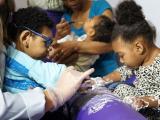Two new studies describe the clinical and virologic presentation of Zika virus in different cohorts of patients during the 2015-2016 outbreak of the flavivirus, noting how symptoms in children may differ by age and highlighting co-morbidities in military veterans.
"Ours is the largest study to date of pediatric Zika, and [it's] one of the largest studies documenting viral load counts," said Jennifer Read, MD, with the Department of Pediatrics at the University of Vermont Medical Center, and senior author of a study published yesterday in JAMA Pediatrics. The study involved 351 Puerto Rican children who were diagnosed as having Zika on or before Dec 31, 2016.
Puerto Rico was one of the hardest-hit regions during the recent Zika outbreak, with 38,000 cases reported from November of 2015 to December of 2016.
Few hospitalizations in kids
The study included 260 participants who were evaluated for Zika symptoms within 3 days of initial symptom onset. Almost all (96.9%) of the 351 total patients returned home after their evaluation, avoiding hospitalization. The most common clinical symptom was fever (99.4%), with rash (79.8%), reddening of the face and neck (69.2%), and fatigue (66.7%) also being likely among patients.
Some symptoms correlated with age, such as headaches; 22 of 69 patients (31.9%) in those aged 1 to 4 years had headaches, compared with 138 of 162 (85.2%) in children 10 to 17 years. Irritability, in contrast, was linked to younger kids, with 56.0% of patients under the age of 1 presenting with that symptom, compared with 21.0% of those ages 10 to 17.
"All of these kids were symptomatic and febrile, but most of the signs and symptoms were non-specific," Read told CIDRAP News. "But the good news was that few required hospitalization." Read was formerly with the US Centers for Disease Control and Prevention in Puerto Rico.
Hospitalization was more likely in younger than older kids, with the median age of the children who were hospitalized at 3.5 years. According to the study, the 10 children hospitalized were admitted because of vomiting, diarrhea, dehydration, loss of appetite, or some combination.
In addition to tracking symptoms, Read and her colleagues measured the viral load of patients through both serum and urine samples, which were collected during the initial clinic visit and 7 to 10 days after symptom onset. Read said viral loads were highest for children on the first day they were symptomatic, but loads looked different depending on if serum or urine was tested—an important distinction.
"Serum viral loads are higher than urine, so you can't compare urine to blood from different patients and make a lot of assumptions about disease severity," she said.
In vets, co-morbidities tied to more severe Zika
In the second study, published late last week in PLoS Neglected Tropical Diseases, a team of researchers looked at Zika presentation in American military veterans who sought care at Veterans Health Administration (VHA) medical centers during the outbreak. Patricia Schirmer, MD, of the VA, and colleagues analyzed data collected from 736 vets who tested positive for Zika from December 2015 through October 2016.
The vast majority of the vets who tested positive for Zika virus (ZIKV) infection were men (89.0%), and 92.8% of all Zika-positive patients were seen in the VA Caribbean Healthcare System (VACHCS). Ninety-four patients (12.8%) were hospitalized, including 19 (2.6%) who died after being diagnosed as having Zika.
Veterans who were older and had co-morbidities such as heart diseases and diabetes were more likely to be hospitalized. According to the study, 62% of veterans in Puerto Rico are 65 years or older and have significant co-morbidities. The mean age of patients in the study was 59.
"The veteran population tends to be older and predominantly male, as reflected in our average age affected," Schirmer said via email. "As the majority of the cases were from Puerto Rico (there is a VA medical center in Puerto Rico) in our study, this follows other research noting high rates of infection in the Caribbean."
"Although we cannot directly link the deaths with ZIKV, the number of deaths was higher among VHA patients compared with a report from Puerto Rico in December 2016 that described only 5 deaths identified by surveillance on the island," the authors of the study concluded.
The study suggests that, in older patients who have significant co-morbidities, Zika infection can be more severe.
See also:
May 29 JAMA Pediatr study
May 24 PLoS Negl Trop Dis study





















